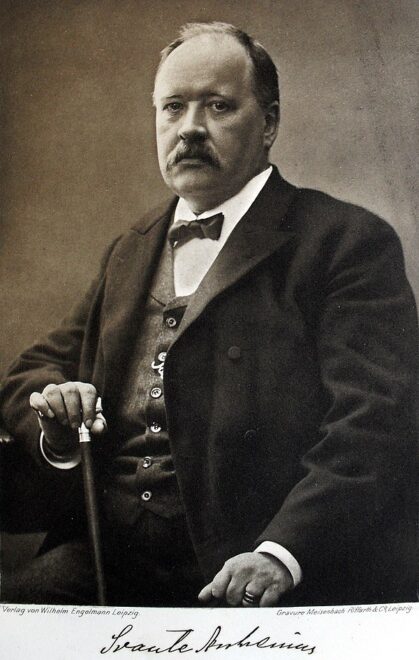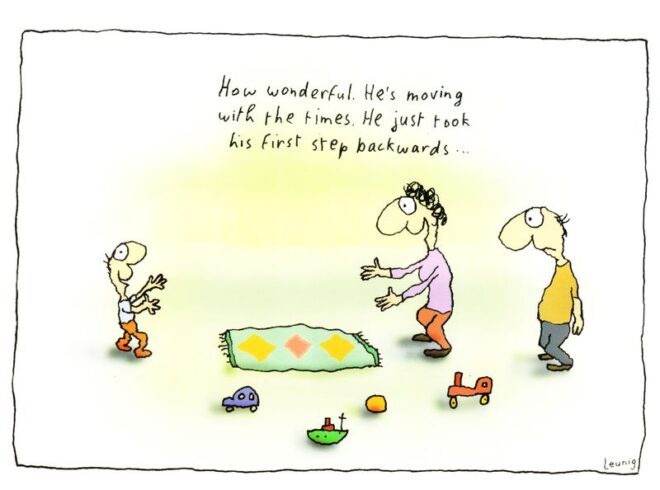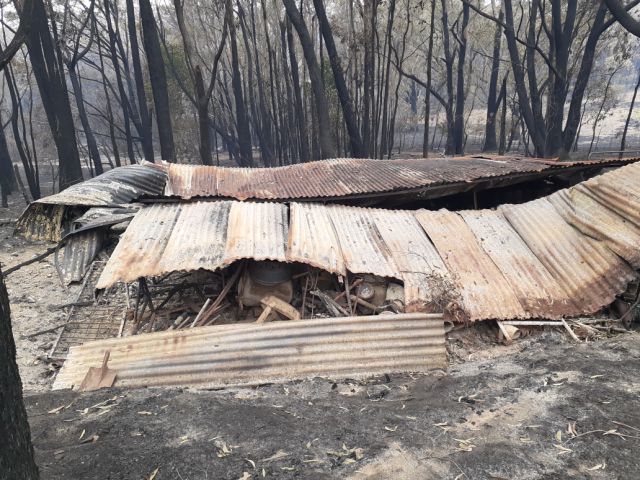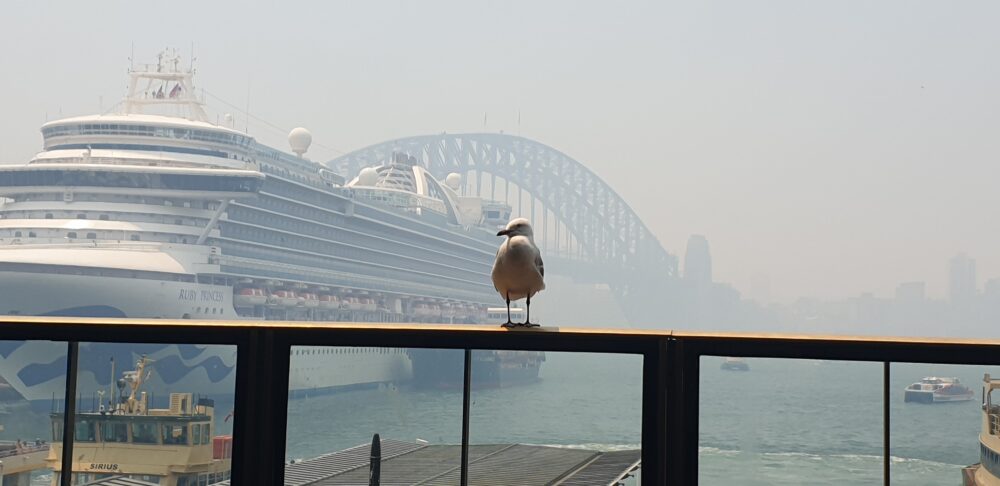Smoke haze from bushfires, Sydney, December 2019, photo Francesca Beddie
I am on the verge of tears of rage. Never in my seven-plus decades have governments been as reckless with their citizenry as those over the last 30 some years. It is not as though Australian governments did not know or were not warned.
[ed. Max Bourke wrote this piece in early 2020, as water bombers including heavy jets and many smaller aircraft were flying low over his home rushing to try to control the Namadgi/Clear Range Fires to the south, which had just destroyed a property his wife and he had spent almost 10 years working on to conserve. The article was first published in the Southern Highlands newsletter.]

In some ways it all started with this − in 1896 Svante Arrhenius, a Swedish physical chemist, building on the work of two French chemists, figured out how much heat the earth trapped thanks to its carbon dioxide blanket. It is as important an equation as Einstein’s better known one:
ΔF=αln(C/C0)
Don’t switch off or go to sleep: it is simple. ΔF, the increase in temperature (measured in watts/sq m, and known technically as radiative forcing) is equal to a constant (now accepted as 5.35, very close to Arrhenius’ first estimation) multiplied by the natural log of the ratio of carbon dioxide increment.
So in plain language the increase in surface temperature of the planet is related to the ratio of carbon dioxide now, relative to that at an earlier time.
From Arrhenius’ time onwards more detailed studies showed that, without the blanket of carbon dioxide around the planet plus other gases, Earth would be an iceball 60 degrees cooler than now and uninhabited, certainly by humans.
Scientists and even non-specialists like myself have known that for decades. Any educated person interested in either biology or the planet knew the basics. As CO2 increases in the atmosphere the amount of heat retained on the surface of Earth changes. This was known and demonstrated 120+ years ago.
Arrhenius’ equation is still used.
In 1957 an American oceanographer, Roger Revelle, wrote that humanity seemed to be conducting a large-scale ‘experiment’ in releasing more and more greenhouse gases into the atmosphere without understanding what might happen. His colleague, Dr David Keeling, then set about establishing the network of carbon dioxide monitoring sites that led to his developing what became known as ‘the Keeling curve’ (made most publicly famous in Al Gore’s An Inconvenient Truth).
In 1979, the World Meteorological Organisation (WMO) organised what became known as the First World Climate Conference at which a resolution calling for immediate steps by governments was passed:
(a) To take full advantage of man’s [sic] present knowledge of climate.
(b) To take steps to improve significantly that knowledge.
(c) To foresee and prevent potential man-made changes in climate that might be adverse to the well-being of humanity.
Sounds fairly anodyne but this would certainly have registered with the Australian Government, as Australia was and had been an active member of the WMO for many decades. The only Australian at that meeting, and there in a private capacity, was Dr WJ (Bill) Gibbs who had been a long serving Director of the Australian Bureau of Meteorology and a member of the WMO. While he had retired the year before, there is no doubt in my mind, as I knew him, he would have ‘reported to government’.
But I suspect it fell into the ‘scientists models, what would they know basket’ of both the bureaucracy and politicians. Let me explain.
Some six or so years before this meeting I had witnessed firsthand the way in which sections of the media and what we would today call ‘influencers’ set out simply to take oppositional points of view for their own sake, without studying any evidence.
In 1972 I had left the ABC Science Unit to return to CSIRO, this time as a writer/producer in their communications unit, instead of as a scientist. I knew a bloke in the Parliamentary Library called Dr Peter Ellyard and it turned out we had both been reading the work of the then new Club of Rome. Alexander King and Aurelio Peccei, the founders, were to visit Australia and sought to meet people who might be interested in the work of this early think tank.
The Founding Members of the Club of Rome set out the ‘Problematique’ They engaged MIT researcher Jay Forrester to use the clunky computers of the time to build what they called a ‘world model’. Over many computer runs this model showed some pretty alarming information about not only planetary health but resource issues, governance of food and health, and their collective impacts on humanity.
Ellyard and I organised a meeting in Old Parliament House (then Parliament House) to which we invited media, ministers and members of parliament. Few came. A couple, such as Dr Moss Cass, later Environment Minister in the Whitlam government, took it seriously, but most were either indifferent to what King and Peccei said or plain outright hostile and dismissive. It was my first foretaste of what the English philosopher A C Grayling calls ‘the waning of the light’. The shift from our several hundred years of ‘enlightenment’ towards the dim future of what we call today fake news. Don’t look at the facts, shoot the messenger.
In 2008 Dr Graham Turner of CSIRO had a look at the forecasts of the Club of Rome over a 30-year period. As he pointed out, despite media reports to the contrary, the Club of Rome did not propose the end of civilization in 2000, but sadly did say:
Thirty years of historical data compare favourably with key features of a business-as-usual scenario called the ‘‘standard run’’ scenario, which results in collapse of the global system midway through the 21st century.
In other words by around 2050 many major elements of what we rely on for our present standard of living will certainly not be available except for the very privileged (and rich) members of humanity. Many of their forecasts were absolutely as predicted. And they were not dealing with carbon in the atmosphere specifically – but the general indifference, indeed hostility, to even considering these sober forecasts. This gave me a foretaste of what was to come.
Meanwhile the 20th century rolls on, people from CSIRO and the Bureau of Meteorology are briefing governments about the looming impact of human-induced climate change.
In 1985 in Villach, Austria an important meeting convened by the WMO, attended by a senior Australian scientist, concluded among other things:
Climate change and sea level rises due to greenhouse gases are closely linked with other major environmental issues, such as acid deposition and threats to the Earth’s ozone shield, mostly due to changes in the composition of the atmosphere by man’s activities. Reduction of coal and oil use and energy conservation undertaken to reduce acid deposition will also reduce emissions of greenhouse gases; a reduction in the release of chloro-fluorocarbons (CFCs) will help protect the ozone layer and will also slow the rate of climate change.
These results would certainly have been relayed to the Australian government and they were made widely available publicly.
In 1988 the WMO and the United Nations Environment Program persuaded the United Nations to establish the Intergovernmental Program on Climate Change, the frequently maligned IPCC. By the bye, the scientists who contribute to that body do it voluntarily, repeat they do not get paid.
A now largely forgotten Labor MP from Victoria, Bob Chynoweth, who held two different seats in his time, played a key role between the scientists and the politicians. He certainly impressed Prime Minister Hawke that climate change was a first-order issue in the late 1980s.
By the late 1980s, Australian scientists were leaders in the field and well sourced studies put the Australian public as among the best informed in the world on this issue. Which is almost certainly where Graham Richardson comes in. There have been some very unflattering things said about Graham Richardson but in 1989 he played a seminal role in trying to get serious consideration of climate change on to the agenda of Federal Cabinet. After an arm wrestle, the first Australian greenhouse gas emissions reduction proposal was submitted to Cabinet, a proposal for a 20% reduction in 1988 Australian greenhouse gas emissions levels by 2005.
So it looked for a while that the Australian government was taking this seriously; then the coal lobby really cranked up its operations. Since then, the retirement enhancement stream of choice for Federal politicians (apart from arms manufacturers) has been the coal and mining industry. A steady stream of mainly Nationals but also Liberals and Labor people have found retirement from federal government made more comfortable with a board seat that requires little effort other than a few phone calls.
But just for a little while it looked like we might be on the right track. Indeed Ministers Kelly and Kerin announcing 0n 11 October 1990 that the Federal Government had set a target similar to that proposed by Richardson said:
The Government recognises the Greenhouse Effect as one of the major environmental concerns facing the world, and that global action and co-operation are needed to combat it.
But then came the ‘lost year’ of 1991 when the main item on the Federal agenda was the rolling maul between Hawke and Keating. The environment came second.
Maria Taylor has well documented in her book Global Warming and Climate change…What Australia knew and buried (you can read it for free at: https://press-files.anu.edu.au/downloads/press/p303951/html/cover.xhtml?referer=&page=0#toc_marker-1) Australia began as a global leader, then started a race to the bottom.
As Taylor quotes in her book:
Australia’s early good knowledge of climate change was documented in a well-credentialed 1989 book that came to a startling conclusion. Following two national greenhouse effect science and public knowledge events staged in 1987 and 1988 by the national science agency the CSIRO and the federal Commission for the Future, earth scientist Ann Henderson-Sellers and her co-author Russell Blong reported on the outcomes of a two-year media and public awareness campaign. They felt able to claim that ‘the awareness of the greenhouse issue is probably greater amongst the general public in Australia than in any other country in the world’.
So the public got it and then lost it?

Sadly, though while there were many admirable policies pursued by Paul Keating, the power of the lobbies and his approach aligning himself with the views of Treasury and some of the strange utterances of the Australian Bureau of Agricultural Research, government ‘leadership’ and indeed interest in climate change began to wane, then change.
By the time the Howard government came to power, the influence of the Institute of Public Affairs and of CRA (now Rio Tinto) and the Minerals Council of Australia was in full force. Warwick Parer, Howard’s minister for this policy area was closely aligned with all of these bodies. As well the role of the so-called Lavoisier Group, with members like Hugh Morgan and former Labor Minister Peter Walsh, former CSIRO Chief Brian Tucker played a significant part in denigration of the science and nullification of any progressive policies.
From then it has all been downhill into the fetid morass of bad public policy and existential threats. That ‘climate policy’ played a role in the shambles of Rudd-Gillard-Rudd-Abbott-Turnbull-Morrison but there was a time before that. Only 12 years ago the Federal Department of Climate Change was proclaiming on its website:
Ultimately Australia faces a choice. We can either wait and allow the challenges to get worse, or we can take action. The Australian people have chosen action. Responsible action on climate change is crucial to Australia’s economic prosperity now and for our children’s future.
What a long way we have come and what an extraordinary amount of time we have lost.
My ‘tears of rage’ at the head of this article are not only for the hole we are now in over climate change but the fact we have moved into a ‘post-enlightenment’ world. Economist Paul Krugman, writing in 2020 in the New York Times, said:
Very few of the people still denying the reality of climate change or at least opposing doing anything about it will be moved by further accumulation of evidence, or even by a proliferation of new disasters. Any action that does take place will have to do so in the face of intractable right-wing opposition.
This means, in turn, that climate action will have to offer immediate benefits to large numbers of voters, because policies that seem to require widespread sacrifice — such as policies that rely mainly on carbon taxes — would be viable only with the kind of political consensus we clearly aren’t going to get.
And once it rains we will forget all about our Black Summer.

Proxies and the pub test
For 120 years what we call proxy observations have been becoming obvious. These range from the shrinking glaciers in mountain ranges (observation by numerous people in Europe from late 19th century to New Zealand tourists in late 20th century); to winemakers observing earlier ripening in France and the ability to grow quality grapes in Wales, Sussex and Belgium; to wheat growers in WA noticing a long-term (30-year) reduction in rainfall of 20 per cent; to gardeners like my wife who keep flowering dates of plants in their patch observing them in bloom over the last 20 years several weeks early. All of these are ‘practical’ and observable products of climate change that ordinary people see. There are many more.
Richard Flanagan wrote in January 2020:
And to the names of those historic betrayers of their people — Vidkun Quisling, Benedict Arnold, Mir Jafar — perhaps one day will be added that of Scott Morrison, the prime minister of Australia who, when faced with the historic tragedy of his country’s destruction, dissembled, enabled, subsidized and oversaw omnicide, until all was ash and even the future was no more.
And if you find this too ‘techy’ or boring try You Tube for a few minutes at: https://www.youtube.com/watch?v=XpqBto89i38&feature=youtu.be&fbclid=IwAR13ED_NqLcvLxdM31BaVmcGYd-gbS7LC2Y_ooH5Z8lv7UUxL9QglhM_k5A
Max Bourke AM has had tertiary education in both science and the arts, he worked as a scientist, then with the ABC Science Unit, back to CSIRO and seconded as Advisor the Whitlam Minister for Science, Bill Morrison. A period on the staff of Dr Nugget Coombs’ Royal Commission led him to the public sector as a Senior and later, Chief executive of various environmental (including Australian Heritage Commission) and arts (including The Australia Council for the Arts) agencies. He served as a Senior Executive in Paul Keating’s Dept of Prime Minister and Cabinet. Leaving the public sector he established the first carbon trading business in Australia which was a failure followed by a farming business which was a success.



Leave a Reply
You must be logged in as a member to post a comment.